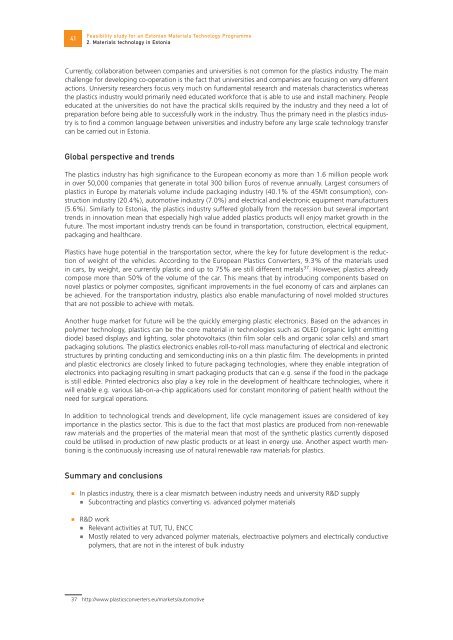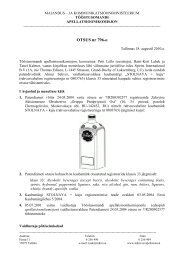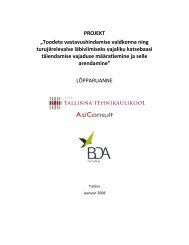Feasibility study for an Estonian Materials Technology Programme
Feasibility study for an Estonian Materials Technology Programme
Feasibility study for an Estonian Materials Technology Programme
Create successful ePaper yourself
Turn your PDF publications into a flip-book with our unique Google optimized e-Paper software.
41<br />
<strong>Feasibility</strong> <strong>study</strong> <strong>for</strong> <strong>an</strong> Estoni<strong>an</strong> <strong>Materials</strong> <strong>Technology</strong> <strong>Programme</strong><br />
2. <strong>Materials</strong> technology in Estonia<br />
Currently, collaboration between comp<strong>an</strong>ies <strong>an</strong>d universities is not common <strong>for</strong> the plastics industry. The main<br />
challenge <strong>for</strong> developing co-operation is the fact that universities <strong>an</strong>d comp<strong>an</strong>ies are focusing on very different<br />
actions. University researchers focus very much on fundamental research <strong>an</strong>d materials characteristics whereas<br />
the plastics industry would primarily need educated work<strong>for</strong>ce that is able to use <strong>an</strong>d install machinery. People<br />
educated at the universities do not have the practical skills required by the industry <strong>an</strong>d they need a lot of<br />
preparation be<strong>for</strong>e being able to successfully work in the industry. Thus the primary need in the plastics industry<br />
is to find a common l<strong>an</strong>guage between universities <strong>an</strong>d industry be<strong>for</strong>e <strong>an</strong>y large scale technology tr<strong>an</strong>sfer<br />
c<strong>an</strong> be carried out in Estonia.<br />
Global perspective <strong>an</strong>d trends<br />
The plastics industry has high signific<strong>an</strong>ce to the Europe<strong>an</strong> economy as more th<strong>an</strong> 1.6 million people work<br />
in over 50,000 comp<strong>an</strong>ies that generate in total 300 billion Euros of revenue <strong>an</strong>nually. Largest consumers of<br />
plastics in Europe by materials volume include packaging industry (40.1% of the 45Mt consumption), construction<br />
industry (20.4%), automotive industry (7.0%) <strong>an</strong>d electrical <strong>an</strong>d electronic equipment m<strong>an</strong>ufacturers<br />
(5.6%). Similarly to Estonia, the plastics industry suffered globally from the recession but several import<strong>an</strong>t<br />
trends in innovation me<strong>an</strong> that especially high value added plastics products will enjoy market growth in the<br />
future. The most import<strong>an</strong>t industry trends c<strong>an</strong> be found in tr<strong>an</strong>sportation, construction, electrical equipment,<br />
packaging <strong>an</strong>d healthcare.<br />
Plastics have huge potential in the tr<strong>an</strong>sportation sector, where the key <strong>for</strong> future development is the reduction<br />
of weight of the vehicles. According to the Europe<strong>an</strong> Plastics Converters, 9.3% of the materials used<br />
in cars, by weight, are currently plastic <strong>an</strong>d up to 75% are still different metals 37 . However, plastics already<br />
compose more th<strong>an</strong> 50% of the volume of the car. This me<strong>an</strong>s that by introducing components based on<br />
novel plastics or polymer composites, signific<strong>an</strong>t improvements in the fuel economy of cars <strong>an</strong>d airpl<strong>an</strong>es c<strong>an</strong><br />
be achieved. For the tr<strong>an</strong>sportation industry, plastics also enable m<strong>an</strong>ufacturing of novel molded structures<br />
that are not possible to achieve with metals.<br />
Another huge market <strong>for</strong> future will be the quickly emerging plastic electronics. Based on the adv<strong>an</strong>ces in<br />
polymer technology, plastics c<strong>an</strong> be the core material in technologies such as OLED (org<strong>an</strong>ic light emitting<br />
diode) based displays <strong>an</strong>d lighting, solar photovoltaics (thin film solar cells <strong>an</strong>d org<strong>an</strong>ic solar cells) <strong>an</strong>d smart<br />
packaging solutions. The plastics electronics enables roll-to-roll mass m<strong>an</strong>ufacturing of electrical <strong>an</strong>d electronic<br />
structures by printing conducting <strong>an</strong>d semiconducting inks on a thin plastic film. The developments in printed<br />
<strong>an</strong>d plastic electronics are closely linked to future packaging technologies, where they enable integration of<br />
electronics into packaging resulting in smart packaging products that c<strong>an</strong> e.g. sense if the food in the package<br />
is still edible. Printed electronics also play a key role in the development of healthcare technologies, where it<br />
will enable e.g. various lab-on-a-chip applications used <strong>for</strong> const<strong>an</strong>t monitoring of patient health without the<br />
need <strong>for</strong> surgical operations.<br />
In addition to technological trends <strong>an</strong>d development, life cycle m<strong>an</strong>agement issues are considered of key<br />
import<strong>an</strong>ce in the plastics sector. This is due to the fact that most plastics are produced from non-renewable<br />
raw materials <strong>an</strong>d the properties of the material me<strong>an</strong> that most of the synthetic plastics currently disposed<br />
could be utilised in production of new plastic products or at least in energy use. Another aspect worth mentioning<br />
is the continuously increasing use of natural renewable raw materials <strong>for</strong> plastics.<br />
Summary <strong>an</strong>d conclusions<br />
In plastics industry, there is a clear mismatch between industry needs <strong>an</strong>d university R&D supply<br />
Subcontracting <strong>an</strong>d plastics converting vs. adv<strong>an</strong>ced polymer materials<br />
R&D work<br />
Relev<strong>an</strong>t activities at TUT, TU, ENCC<br />
Mostly related to very adv<strong>an</strong>ced polymer materials, electroactive polymers <strong>an</strong>d electrically conductive<br />
polymers, that are not in the interest of bulk industry<br />
37 http://www.plasticsconverters.eu/markets/automotive





